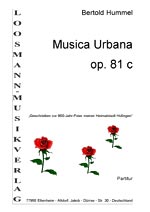Musica urbana for Wind Orchestra op. 81c (1984)

I. Fanfare and Chorale
II.
March ![]() beginning
beginning
III. Folk-song and conclusion
Première:
July 14, 1984, Hüfingen, Stadthalle
Hüfinger Stadtmusik / Bertold
Hummel
Instrumentation: Picc., Fl., 2 Ob., Clar. i. Es, 3 Clar. i. B, BassClar. i. B, Bassoon., Soprano-Sax. i. B, 2 Alto-Sax. i. Es, Tenor-Sax. i. B, Bariton-Sax. i. Es, 3 Trp. i. B, 3 Waldhrn. i. Es (F), 3 Trombones., 3 Cornette i. B, 3 Tenortb. i. B, 2 Bariton-Tb., 2 Baßtb., Timp., Perc. <3>
Duration: 17 Minutes
Publisher:
Loosmann B 0059
![]() CD available:
Tirol 1809 Markgräfler Verbands Blasorchester / Bernhard Volk - Musik
Gillhaus Freiburg (Information@Musik-Gillhaus.de)
CD available:
Tirol 1809 Markgräfler Verbands Blasorchester / Bernhard Volk - Musik
Gillhaus Freiburg (Information@Musik-Gillhaus.de)
Video: Works by Hummel on youtube
This work was written
for the 900th anniversary of the founding of my native town Hüfingen in 1985.
A whole series of memories from childhood found their way into the 3 movements
of this commission.
The first movement, Fanfare and Chorale,
relates to a number of solemn moments and to chorale themes from the famous Corpus
Christi procession in Hüfingen. ("Lobe den Herren")
In the
2nd movement, March, a locally popular march motif appears in an
occasionally ironic-grotesque treatment. ("Ei, de David, wenn´d ä
Brod witt ..[Ah, our David, when he wants bread....]")
The Finale:
Folk-song and conclusion contrasts a setting of a gentle folk-song from
the Black Forest ("I han an eim Ort ä Blümli gseh´, ä
Blümli rot und wiß..[I saw in that place a flower, a flower white and
red..] ") with the March of the Hüfingen Jesters ("Hans gang hom
[Hans went home]"), which appears on various planes of tempo and leads with
numerous changes between major and minor to an effective close. The work was given
its first performance, in the originally more restricted instrumentation, by the
"Stadtmusik Hüfingen [City Band Hüfingen]", directed by the
composer, in July, 1985.
Bertold Hummel
As
I then started the composition, many childhood memories came back to me, spontaneously
creating an inner relationship with Hüfingen. There was for example the memory
of my father playing the organ in Hüfingen central church and the first acquaintance
with chorale and hymn melodies. There were the memories of the lively marches
of the Hüfinger Fasnet (carnival) and the stately melodies of the
Corpus Christi procession. I also remembered the practice of folk-singing
in domestic surroundings - in the Schellenberg House nearby. Thus a work - with
the title Musica Urbana - took shape and can be described as follows:
The 1st Movement - Fanfare and Chorale - is suited to the dignity and solemnity
of the occasion today. The chorale melody "Lobe den Herren" -
quoted in its entirety three times - is accompanied by the most varied motifs,
which are taken from the introductory Fanfare and from the Chorale
itself .
The 2nd Movement bears the title March. Here you find as a counter-subject
a melody which during my childhood in Hüfingen had the following text: "David
wenn de Brot witt, in de Schublad liit en Aschnitt" (for non-Hüfinger
roughly: "David, if want bread, you'll find a crust in the drawer").
After some turbulent passages, the march surprisingly flows into a valse - triste,
although only for a few bars. It is trumped by a closing gesture which wipes away
any traces of resignation which might have begun to appear.
In the following
3rd part of the work - Folk-song and Finale - a folk-song is the first
source of material: "Han amenort ä Bluemli gsäh, ä Bluemli
rot un wiiss" ("I spied a little flower in a certain place, a
flower blooming red and white "). In contrast, a song known to all Hüfingers,
"Hans blieb do, du woascht jo nit wiäs Wetter wird" , then
enters the scene. With wide-ranging variations on this theme, "Musica
Urbana" , dedicated to Hüfingen and its citizens, reaches an almost
symphonic conclusion.
Bertold Hummel (Extract from his speech at the première
on the 14th July, 1984 in Hüfingen.)
Works
for (amateur) wind orchestra
At the end of this look at Bertold Hummel's
symphonic work, some remarks on his writing for amateur musicians is necessary.
In this field, he is very much in the tradition of his teachers Genzmer and Hindemith,
who similarly never lost their rapport with the practices of the non-professional
musician. A natural maxim applies: the simpler the concept, the more diatonic
and small-scale the building blocks and sounds. The aspect of sound colour becomes
less important and the compositional characteristics are more strongly centred
on draughtsman-like linear structures with a significantly conventional effect.
Of the symphonic works, those for wind orchestra are among the simpler ones.
Specifically conceived for amateurs were the "Sinfonietta", op. 39 (1970)
and the "Musica Urbana", op. 81c, composed in 1983 and baptised a year
later in Hummel's birthplace, Hüfingen, under his direction with local musicians.
At a slightly more demanding level, Hummel composed in 1977 the "Oregon Symphony",
op. 67, performed for the first time on the 7th April, 1978 in Ashland, Oregon
(USA) in the presence of the composer. Nine years later, during his second visit
to the USA, Hummel had the "Symphonic Overture", op. 81d (the extended
"Oregon Symphony") in his luggage and had this performed for the first
time in Seattle on the 21st November, 1987 by the W.I.B.C Directors' Band.
Claus Kühnl (in "Die sinfonischen Werke Bertold
Hummels", Tutzing, 1998)